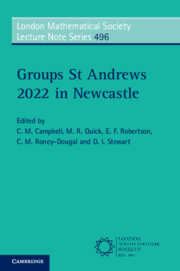Book contents
- Frontmatter
- Contents
- Introduction
- 1 Finite group schemes
- 2 Algorithms for polycyclic groups
- 3 The spread of finite and infinite groups
- 4 Discrete subgroups of semisimple Lie groups, beyond lattices
- 5 Complete reducibility and subgroups of exceptional algebraic groups
- 6 Axial algebras of Jordan and Monster type
- 7 An introduction to the local-to-global behaviour of groups acting on trees and the theory of local action diagrams
- 8 Finite groups and the class-size prime graph revisited
- 9 Character bounds for finite simple groups and applications
- 10 Generalized Baumslag-Solitar groups: a topological approach
- References
5 - Complete reducibility and subgroups of exceptional algebraic groups
Published online by Cambridge University Press: 21 November 2024
- Frontmatter
- Contents
- Introduction
- 1 Finite group schemes
- 2 Algorithms for polycyclic groups
- 3 The spread of finite and infinite groups
- 4 Discrete subgroups of semisimple Lie groups, beyond lattices
- 5 Complete reducibility and subgroups of exceptional algebraic groups
- 6 Axial algebras of Jordan and Monster type
- 7 An introduction to the local-to-global behaviour of groups acting on trees and the theory of local action diagrams
- 8 Finite groups and the class-size prime graph revisited
- 9 Character bounds for finite simple groups and applications
- 10 Generalized Baumslag-Solitar groups: a topological approach
- References
Summary
This survey article has two components. The first part gives a gentle introduction to Serres notion of $G$-complete reducibility, where $G$ is a connected reductive algebraic group defined over an algebraically closed field. The second part concerns consequences of this theory when $G$ is simple of exceptional type, specifically its role in elucidating the subgroup structure of $G$. The latter subject has a history going back about sixty years. We give an overview of what is known, up to the present day. We also take the opportunity to offer several corrections to the literature.
- Type
- Chapter
- Information
- Groups St Andrews 2022 in Newcastle , pp. 191 - 245Publisher: Cambridge University PressPrint publication year: 2024

